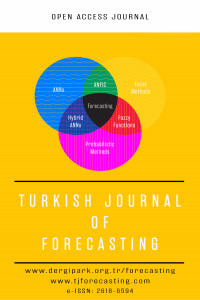Time Series Prediction with Direct and Recurrent Neural Networks
Time Series Prediction with Direct and Recurrent Neural Networks
___
- Lam M., Neural network techniques for financial performance prediction: integrating fundamental and technical analysis. Decision Support Systems 37, 2004; 567-581.
- Yao J.T., Towards a better forecasting model for economic indices. In: Proceedings of the 6th Joint Conference on Information Science, 2002; 299-303.
- José M. Menezes Jr. & Guilherme A. Barreto A New Look at Nonlinear Time Series Prediction with NARX Recurrent Neural Network, IX Brazilian Neural Networks Symposium (SBRN'2006), (2006), Ribeirão Preto-SP.
- S. Crone (2005) Stepwise Selection of Artificial Neural Network Models for Time Series Prediction, Journal of Intelligent Systems, Vol. 14, No. 2-3, 2005, pp. 99-122.
- De Campos L.M.L, R. M., A Biologically inspired methodology for neural networks design In: IEEE Conference on Cybernetics and Intelligent Systems. IEEE, pp. 619-624, 2004.
- Cant-Paz, E. and C. Kamath, An empirical comparison of combinations of evolutionary algorithms and neural networks for classification problems, IEEE Transactions on Systems, Man, and Cybernetics-Part B: Cybernetics, pages 915-927, 2007.
- N. Feng, G. Ning, and X. Zheng, A Framework for simulating axon guidance, In: Proceedings of Neuro computing, 2005, pp.70-84.
- De Campos, Lídio Mauro Lima ; Roisenberg, Mauro ; Oliveira, Roberto Célio Limão de . (Accept) Automatic Design of Neural Networks with L-Systems and Genetic Algorithms - A Biologically Inspired Methodology. IJCNN 2011 - IEEE International Joint Conference on Neural Networks – San Jose, California, USA, 2011.
- M.Tomita. Dynamic construction of Finite automata from examples using hill-climbing. In: Proceedings of the Fourth Annual Conference of the Cognitive Science Society. Ann Arbor, MI, pp. 105-108, 1982.
- Aguirre, L.A., Introdução à Identificação de Sistemas, Editora UFMG, terceira edição, 2007.
- PARK, D. C. et. al. Electrical load forecasting using an artificial neural network. Artificial Neural Network: forecasting time series. E.U.A., IEEE Press, p. 43-49, 1994.
- LIN, T. et al. Learning long-term dependencies in NARX recurrent neural networks. IEEE Transactions on Neural Networks, v. 7, n. 6, p. 1424_1438, 1996.
- Yayın Aralığı: Yılda 2 Sayı
- Başlangıç: 2017
- Yayıncı: Giresun Üniversitesi
An Enhanced Neural-based Bi-Component Hybrid Model for Foreign Exchange Rate Forecasting
Mehdi KHASHEİ, Sheida TORBAT, Zahra HAJİ RAHİMİ
Multi-layer Perceptron and Pruning
Cyril VOYANT, Christophe PAOLİ, Marie-laure NİVET, Gilles NOTTON, Alexis FOUİLLOY, Fabrice MOTTE
Guckan YAPAR, İdil YAVUZ, Hanife TAYLAN SELAMLAR
Time Series Prediction with Direct and Recurrent Neural Networks
